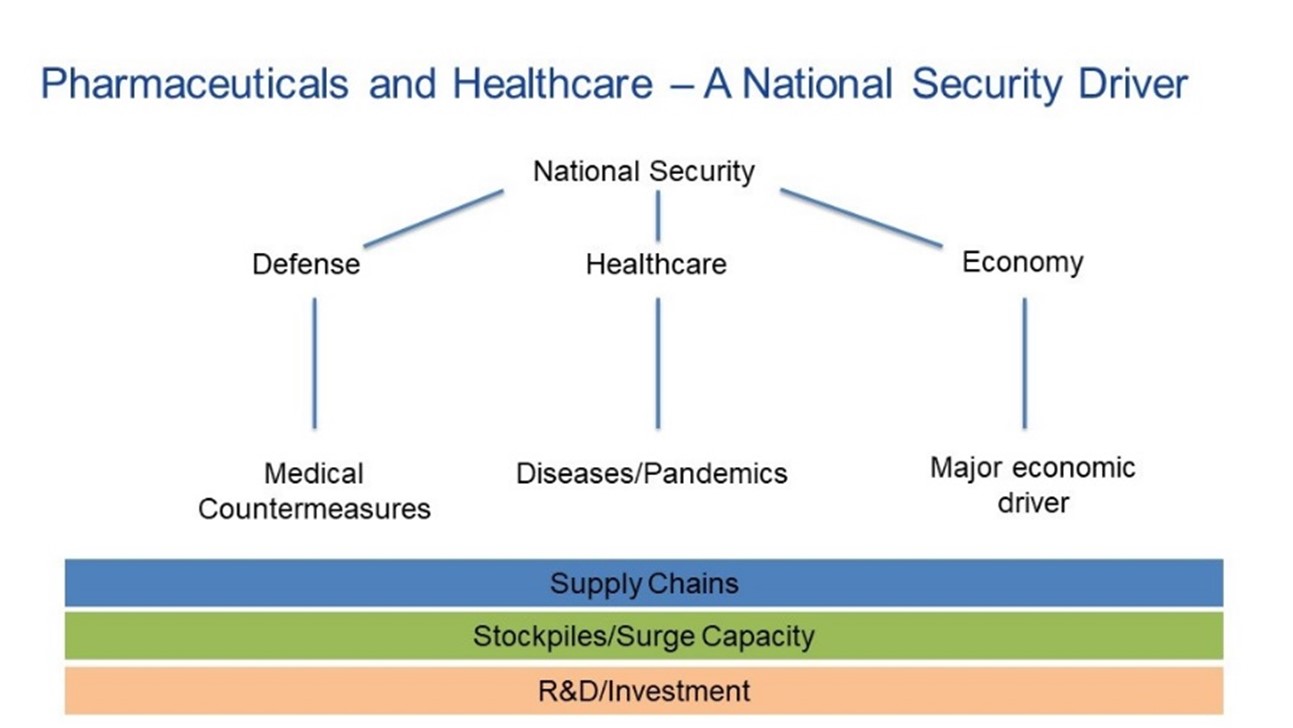In a previous blog, we discussed the integrity and resiliency of the supply chains for healthcare products and pharmaceuticals, focusing on how these issues are a matter of national security. During our Spring Training Conference, we were fortunate to have Moshe Schwartz, President of Etherton and Associates, dig deeper into the three pillars that make up national security and how recent events, including the COVID-19 pandemic and inflation, have reshaped our nation’s thinking about them. These three pillars include defense, healthcare, and economy. During his remarks, Schwartz emphasized that healthcare underpins each of the three the pillars. The chart below outlines the components of national security and how healthcare plays a crucial role in each. Additionally, the figure demonstrates that supply chains, stockpiles and surge capacity, and research and development cut across all three elements of national security.

The first key component of national security highlighted above is military defense. The defense pillar encapsulates the protection of our nation against foreign adversaries and the threat of terrorism. In order to ensure that the warfighter can effectively protect the nation, it is vital that the armed services have access to the latest healthcare supplies and pharmaceuticals. Without a healthy active military, the ability to defend against the risk of attacks from outside threats would be greatly hindered. It is equally important to provide the best healthcare for our veterans post service. Additionally, the healthcare and pharmaceutical industries are essential to the defense against biological and chemical weapons. In a technologically evolving world, the military must have access to the appropriate medical countermeasures to eliminate these potential hazards. Finally, the relationship between defense and healthcare is shown through several advancements in medicine and medical technologies as the result of military investment.
The second pillar shaping national security is healthcare, which includes the health and wellness of the American people. The effect of the COVID-19 pandemic is particularly crucial to this component of security. According to the Centers for Disease Control (CDC), “COVID-19 was associated with approximately 460,000 deaths in the U.S. during January-December 2021.” Also notably, in 2021 COVID-19 remained the third leading cause of death in the country behind heart disease and cancer. CDC statistics show that from 2019 to 2020, life expectancy dropped from 78.8 years to 77.3 years, citing the pandemic as the primary cause of the decrease. Response to the pandemic was critical to preserving national security. Operation Warp Speed (OWS), an effort led by multiple government agencies, including the Department of Defense and the Department of Health and Human Services, accelerated the delivery of hundreds of millions of vaccines, therapeutics, and diagnostics to Americans. While ultimately successful, OWS was impeded by a lack of stockpiles and a lack of infrastructure capable of more quickly surging resources to develop and distribute the vaccine. A shortage in personal protective equipment was also a result of sparce stockpiles and surge capacity limits. COVID-19 provided insights into the importance of medical readiness, and offered lessons learned to address future pandemics. Effective pharmaceuticals and healthcare products are always fundamental to combatting diseases and ensuring the health of our nation as a whole.
The third and final pillar of national security is economy. Economic security is important for promoting growth, innovation, and development within a nation. Healthcare plays a major role in the U.S. economy. As mentioned in the last blog, healthcare spending represented 19.7 percent of the U.S. Gross Domestic Product in 2020 (Centers for Medicare & Medicaid Services). Additionally, according to the Brookings Institution, healthcare spending accounted for 17.7 percent of the U.S. economy and 24 percent of government spending in 2018. Also, as of 2019, the healthcare sector employed 11 percent of Americans. Consequently, disruptions to the pharmaceutical and healthcare product supply chains would have grave impacts on the country’s economy. Currently, the U.S. relies heavily on foreign sources for raw ingredients for pharmaceuticals, personal protective equipment, and medical equipment. These supply chains also remain vulnerable to cyber threats. More resilient American supply chains will strengthen domestic manufacturing capabilities, and sturdy supply chains with allies will greatly benefit national security.
In order to maintain a resilient healthcare capability, the U.S. must take steps to strengthen supply chains, build stockpiles and surge capacity, and invest in research and development. These areas directly impact the three pillars of national security. Strengthening these components will help us be better prepared to respond to the next health national security threat, whether it comes in the form of a pandemic or a foreign adversary. The meaning of national security has evolved with these unique current events, and as Schwartz said in his speech, “the decisions that get made over the next couple of years are going to influence how we do things going forward.”